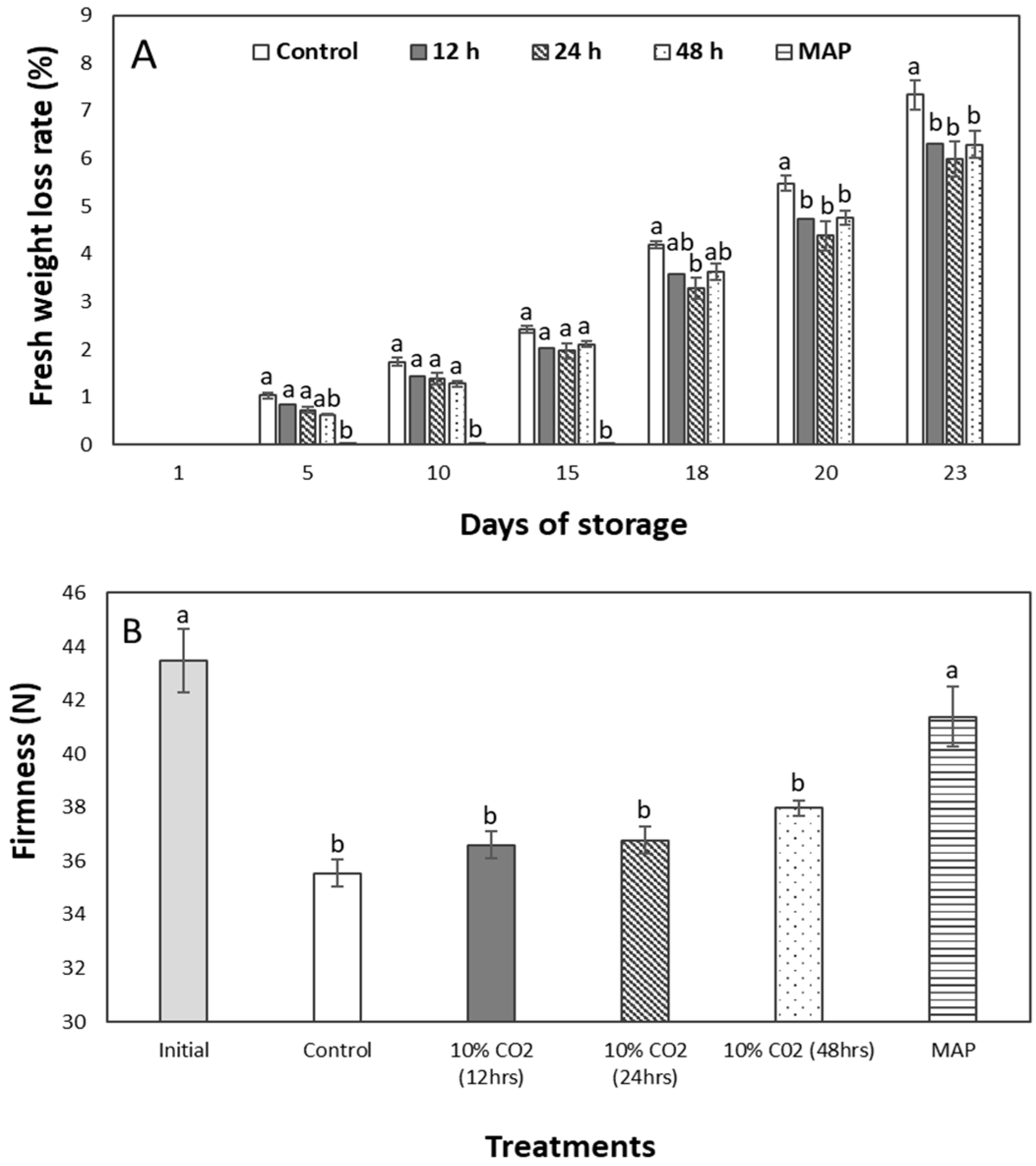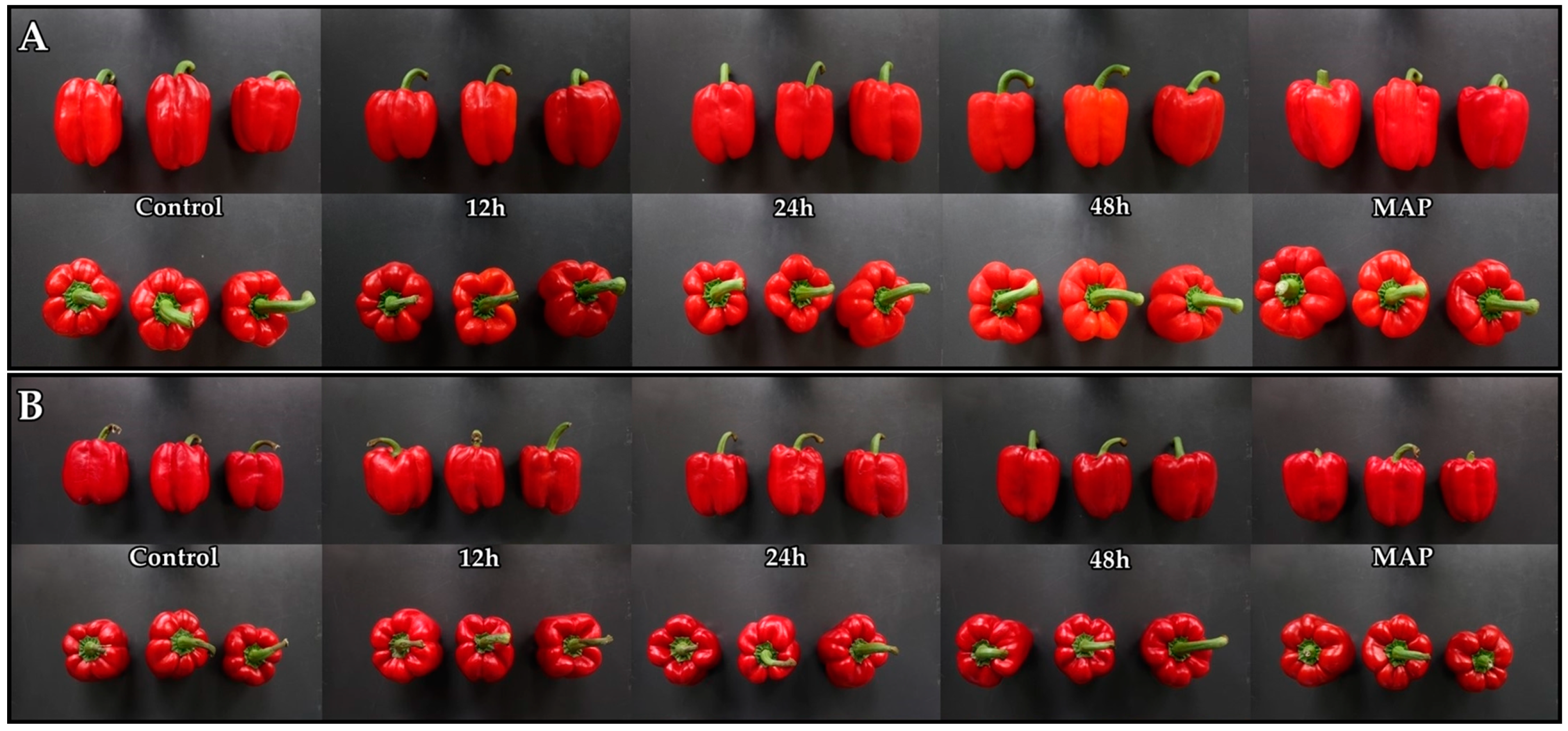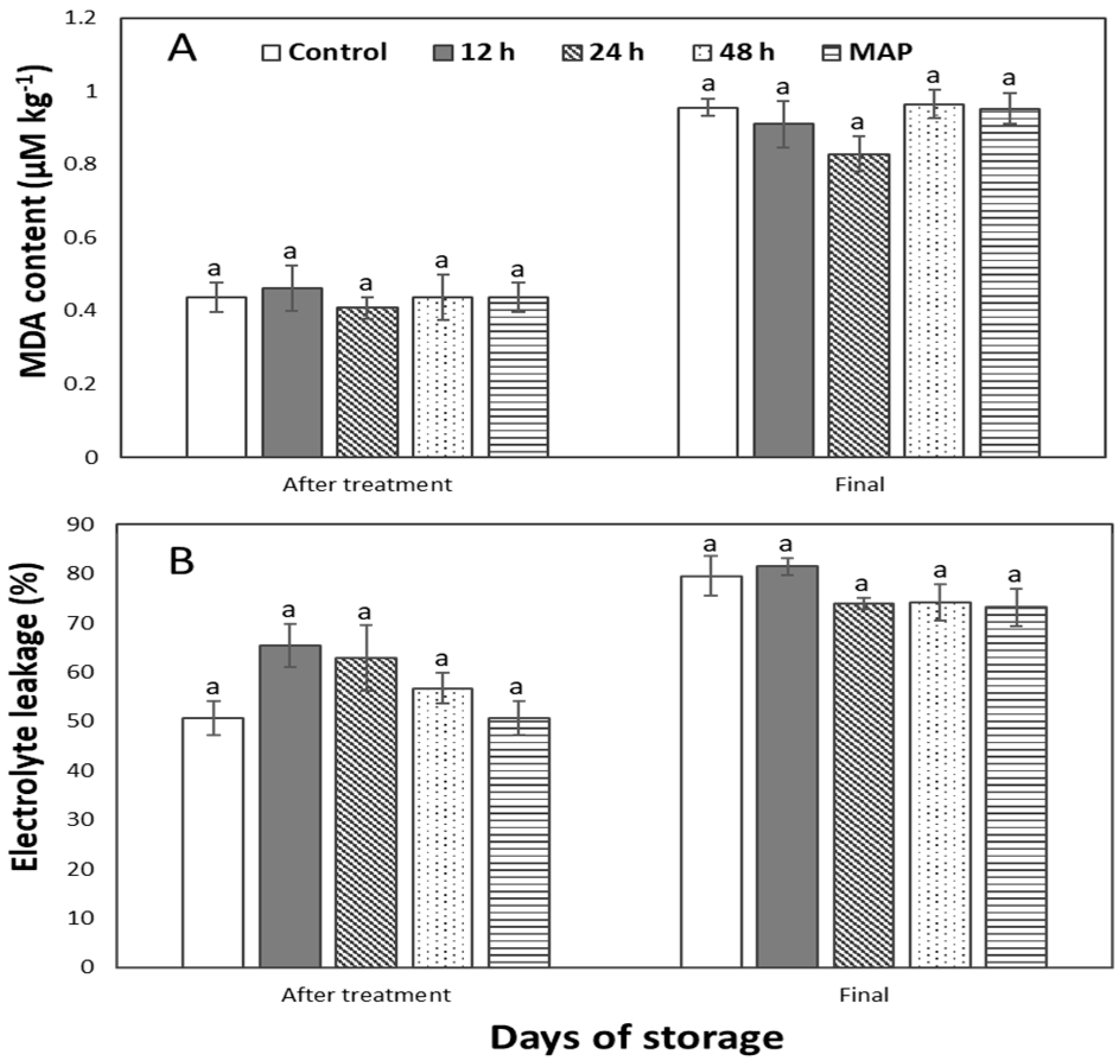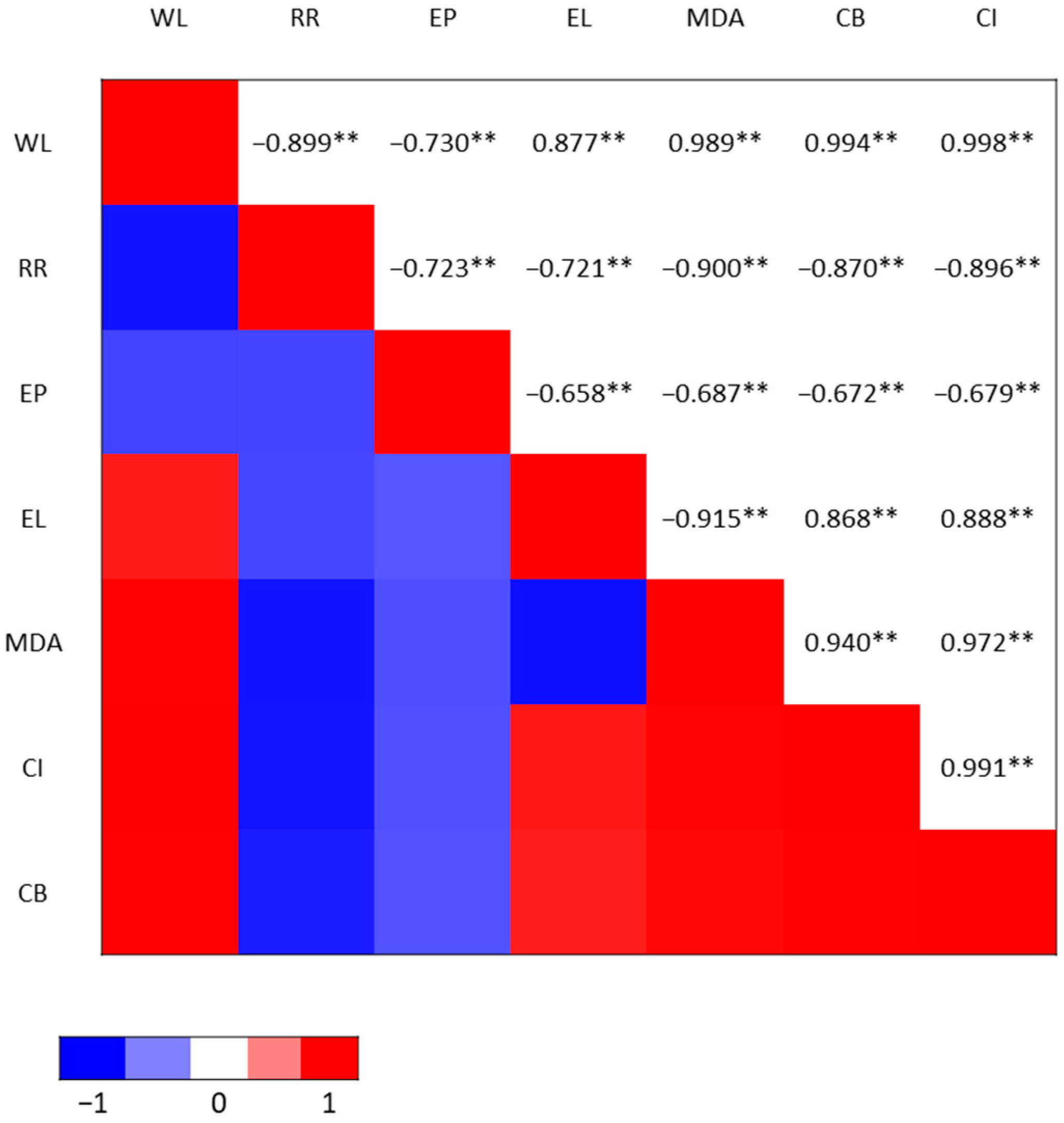Effect of Pre-Storage CO2 Treatment and Modified Atmosphere Packaging on Sweet Pepper Chilling Injury
Abstract
:1. Introduction
2. Results
2.1. Weight Loss and Firmness
2.2. Chilling Injury and Calyx Browning Index
2.3. Gas Production Rates and Concentration in Modified Atmosphere Packaging (MAP)
2.4. Malondialdehyde (MDA) Assay and Electrolyte Leakage
2.5. Soluble Solids Content
2.6. Correlation Analysis
3. Discussion
4. Materials and Methods
4.1. Fruit Treatment and Storage Conditions
4.2. Malondialdehyde (MDA) Assay and Electrolyte Leakage
4.3. Gas Production Rates and Concentration in Modified Atmosphere Packaging (MAP)
4.4. Weight Loss and Firmness
4.5. Chilling Injury Index and Calyx Browning
4.6. Soluble Solids Content
4.7. Statistical Analysis
5. Conclusions
Author Contributions
Funding
Acknowledgments
Conflicts of Interest
References
- Lim, C.S.; Kang, S.M.; Cho, J.L.; Gross, K.C.; Woolf, A.B. Bell pepper (Capsicum annuum L.) fruits are susceptible to chilling injury at the breaker stage of ripeness. HortScience 2007, 42, 1659–1664. [Google Scholar] [CrossRef]
- Babellahi, F.; Paliwal, J.; Erkinbaev, C.; Amodio, M.L.; Chaudhry, M.M.A.; Colelli, G. Early detection of chilling injury in green bell peppers by hyperspectral imaging and chemometrics. Postharvest Biol. Technol. 2020, 162, 111100. [Google Scholar] [CrossRef]
- Serrano, M.; Martínez-Madrid, M.C.; Pretel, M.T.; Riquelme, F.; Romojaro, F. Modified atmosphere packaging minimizes increases in putrescine and abscisic acid levels caused by chilling injury in pepper fruit. J. Agric. Food Chem. 1997, 45, 1668–1672. [Google Scholar] [CrossRef]
- Kader, A.A. Postharvest Technology of Horticultural Crops. University of California Agriculture and Natural Resources: Davis, CA, USA, 2002; Volume 3311. [Google Scholar]
- Afolabi, A.S.; Choi, I.L.; Lee, J.H.; Beom, K.Y.; Kang, H.M. Comparison of Storability and Quality of Sweet Pepper (Capsicum annum L.) Grown in Two Different Hydroponics Media. Korean J. Packag. Sci. Technol. 2022, 28, 39–46. [Google Scholar] [CrossRef]
- Mathooko, F.M.; Kubo, Y.; Inaba, A.; Nakamura, R. Induction of ethylene biosynthesis and polyamine accumulation in cucumber fruit in response to carbon dioxide stress. Postharvest Biol. Technol. 1995, 5, 51–65. [Google Scholar] [CrossRef]
- Miller, W.R.; Hale, P.W.; Spalding, D.H.; Davis, P. Quality and decay of mango fruit wrapped in heat-shrinkable film. HortScience 1983, 18, 957–958. [Google Scholar] [CrossRef]
- Luo, Y.; Mikitzel, L.J. Extension of postharvest life of bell peppers with low oxygen. J. Sci. Food Agric. 1996, 70, 115–119. [Google Scholar] [CrossRef]
- Taye, A.M.; Tilahun, S.; Do Su Park, M.H.S.; Jeong, C.S. Effects of continuous application of CO2 on fruit quality attributes and shelf life during cold storage in cherry tomato. Hortic. Sci. Technol. 2017, 35, 300–313. [Google Scholar]
- Besada, C.; Llorca, E.; Novillo, P.; Hernando, I.; Salvador, A. Short-term high CO2 treatment alleviates chilling injury of persimmon cv. Fuyu by preserving the parenchyma structure. Food Control 2015, 51, 163–170. [Google Scholar] [CrossRef]
- Wang, L.-X.; Choi, I.-L.; Kang, H.-M. Effect of High CO2 Treatment and MA packaging on sensory quality and physiological-biochemical characteristics of green asparagus (Asparagus officinalis L.) during postharvest storage. Horticulturae 2020, 6, 84. [Google Scholar] [CrossRef]
- Kader, A.A.; Zagory, D.; Kerbel, E.L.; Wang, C.Y. Modified atmosphere packaging of fruits and vegetables. Crit. Rev. Food Sci. Nutr. 1989, 28, 1–30. [Google Scholar] [CrossRef]
- Serrano, M.; Pretel, M.T.; Martínez-Madrid, M.C.; Romojaro, F.; Riquelme, F. CO2 treatment of zucchini squash reduces chilling-induced physiological changes. J. Agric. Food Chem. 1998, 46, 2465–2468. [Google Scholar] [CrossRef]
- Win, N.M.; Yoo, J.; Lee, J.; Jung, H.Y.; Kang, I.K. Effect of different CO2 deastringency application timing on fruit quality attributes and physiological disorders in cold-stored ‘Sangjudungsi’persimmon fruit. Hortic. Sci. Technol. 2019, 37, 395–403. [Google Scholar]
- Wang, C. Effect of CO2 Treatment on Storage and Shelf Life of Sweet Peppers1. J. Am. Soc. Hortic. Sci. 1977, 102, 808–812. [Google Scholar] [CrossRef]
- Afolabi, A.S.; Choi, I.L.; Lee, J.H.; Kwon, Y.B.; Kang, H.M. High-Relative-Humidity Storage Reduces the Chilling Injury Symptoms of Red Sweet Peppers in the Breaker Stage. Horticulturae 2023, 9, 116. [Google Scholar] [CrossRef]
- Valenzuela, J.L.; Manzano, S.; Palma, F.; Carvajal, F.; Garrido, D.; Jamilena, M. Oxidative stress associated with chilling injury in immature fruit: Postharvest technological and biotechnological solutions. Int. J. Mol. Sci. 2017, 18, 1467. [Google Scholar] [CrossRef] [PubMed]
- Morales, J.; Cervera, L.; Navarro, P.; Salvador, A. Quality of Postharvest Degreened Citrus Fruit. In Advances in Citrus Production and Research; IntechOpen: London, UK, 2022. [Google Scholar]
- Kubo, Y.; Inaba, A.; Nakamura, R. Effects of high CO2 on respiration in various horticultural crops. J. Jpn. Soc. Hortic. Sci. 1989, 58, 731–736. [Google Scholar] [CrossRef]
- Fahmy, K.; Violalita, F.; Chatib, O.C.; Yulia, R.; Nakano, K. The individual influences of high CO2 on chilling injury suppression of ‘Merah Delima’papaya fruit. IOP Conf. Ser. Earth Environ. Sci. 2019, 230, 012016. [Google Scholar] [CrossRef]
- Lim, C.S.; Kang, S.M.; Cho, J.L.; Gross, K.C. Antioxidizing enzyme activities in chilling-sensitive and chilling-tolerant pepper fruit as affected by stage of ripeness and storage temperature. J. Am. Soc. Hortic. Sci. 2009, 134, 156–163. [Google Scholar] [CrossRef]
- Wang, Q.; Ding, T.; Gao, L.; Pang, J.; Yang, N. Effect of brassinolide on chilling injury of green bell pepper in storage. Sci. Hortic. 2012, 144, 195–200. [Google Scholar] [CrossRef]
- Zuo, X.; Cao, S.; Zhang, M.; Cheng, Z.; Cao, T.; Jin, P.; Zheng, Y. High relative humidity (HRH) storage alleviates chilling injury of zucchini fruit by promoting the accumulation of proline and ABA. Postharvest Biol. Technol. 2021, 171, 111344. [Google Scholar] [CrossRef]







| Respiration Rate (CO2 mg kg−1 h−1) | ||||||
|---|---|---|---|---|---|---|
| Treatment | Harvest | After Treatment | Day 15 | Day 18 | Day 20 | Treatment |
| Control | 12.50 ± 0.67 | 13.19 ± 1.15 b z | 16.77 ± 1.06 ab | 5.22 ± 0.36 a | 7.10 ± 0.28 a | ** |
| 12 h | 13.82 ± 0.50 b | 16.73 ± 0.96 a | 6.90 ± 1.06 a | 7.30 ± 0.53 a | *** | |
| 24 h | 18.77 ± 0.73 a | 13.37 ± 0.75 b | 5.54 ± 0.41 a | 6.90 ± 0.45 a | *** | |
| 48 h | 19.91 ± 1.78 a | 17.15 ± 0.90 ab | 5.72 ± 0.15 a | 6.25 ± 0.58 a | *** | |
| MAP | 13.19 ± 1.15 b | 18.04 ± 0.93 a | 5.76 ± 0.23 a | 7.45 ± 0.22 a | *** | |
| Ethylene Production Rate (µL kg−1 h−1) | ||||||
|---|---|---|---|---|---|---|
| Treatment | Harvest | After Treatment | Day 15 | Day 18 | Day 20 | Treatment |
| Control | 2.10 ± 0.07 | 2.45 ± 0.40 a z | 1.14 ± 0.08 ab | 1.16 ± 0.17 a | 1.29 ± 0.08 a | * |
| 12 h | 1.91 ± 0.70 a | 1.63 ± 0.05 a | 0.94 ± 0.04 a | 0.77 ± 0.09 ab | * | |
| 24 h | 1.70 ± 0.65 a | 1.30 ± 0.18 ab | 0.99 ± 0.09 a | 0.81 ± 0.09 ab | * | |
| 48 h | 2.52 ± 0.87 a | 0.78 ± 0.04 b | 1.07 ± 0.09 a | 0.57 ± 0.02 b | *** | |
| MAP | 2.45 ± 0.40 a | 1.04 ± 0.12 ab | 1.19 ± 0.13 a | 0.67 ± 0.07 ab | * | |
Disclaimer/Publisher’s Note: The statements, opinions and data contained in all publications are solely those of the individual author(s) and contributor(s) and not of MDPI and/or the editor(s). MDPI and/or the editor(s) disclaim responsibility for any injury to people or property resulting from any ideas, methods, instructions or products referred to in the content. |
© 2023 by the authors. Licensee MDPI, Basel, Switzerland. This article is an open access article distributed under the terms and conditions of the Creative Commons Attribution (CC BY) license (https://creativecommons.org/licenses/by/4.0/).
Share and Cite
Afolabi, A.S.; Choi, I.-L.; Lee, J.H.; Kwon, Y.B.; Yoon, H.S.; Kang, H.-M. Effect of Pre-Storage CO2 Treatment and Modified Atmosphere Packaging on Sweet Pepper Chilling Injury. Plants 2023, 12, 671. https://doi.org/10.3390/plants12030671
Afolabi AS, Choi I-L, Lee JH, Kwon YB, Yoon HS, Kang H-M. Effect of Pre-Storage CO2 Treatment and Modified Atmosphere Packaging on Sweet Pepper Chilling Injury. Plants. 2023; 12(3):671. https://doi.org/10.3390/plants12030671
Chicago/Turabian StyleAfolabi, Abiodun Samuel, In-Lee Choi, Joo Hwan Lee, Yong Beom Kwon, Hyuk Sung Yoon, and Ho-Min Kang. 2023. "Effect of Pre-Storage CO2 Treatment and Modified Atmosphere Packaging on Sweet Pepper Chilling Injury" Plants 12, no. 3: 671. https://doi.org/10.3390/plants12030671
APA StyleAfolabi, A. S., Choi, I.-L., Lee, J. H., Kwon, Y. B., Yoon, H. S., & Kang, H.-M. (2023). Effect of Pre-Storage CO2 Treatment and Modified Atmosphere Packaging on Sweet Pepper Chilling Injury. Plants, 12(3), 671. https://doi.org/10.3390/plants12030671






